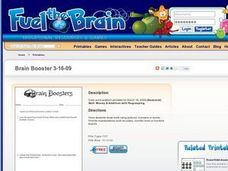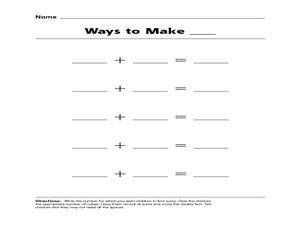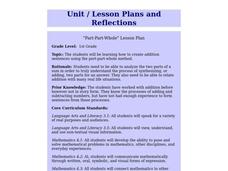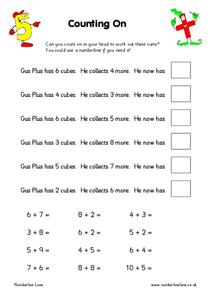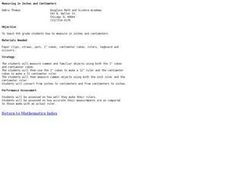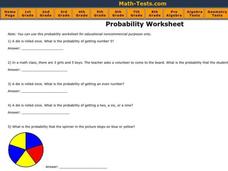K12 Reader
3-D: It’s Not Just for Movies
This two-part reading comprehension exercise asks kids to read a short passage about cubes, rectangular prisms, spheres and pyramids, and then to respond to a series of questions about the article.
Teach Engineering
Let's Take a Spin: One-Axis Rotation
Investigate the effect of one-axis rotations on geometric figures. Scholars learn to use snap cubes and the right-hand rule to draw figures after rotations about the x-, y-, or z-axes. They try their hands at examples created by the...
Royal Society of Chemistry
Units of Volume
Did you know in the UK a quart is smaller than in America? This explains why a standard unit of measure is necessary for volume. Young scientists learn the similarities and differences between five different units used to measure volume....
K5 Learning
Changes
You can't unring a bell, but can you unmelt an ice cube? Readers consider reversible and irreversible changes with a short informational reading passage and accompanying comprehension questions.
August House
The Ogre Bully
English language arts, math, science, dramatic arts, and cooking; this lesson has it all! In this multidisciplinary resource, your scholars will take part in a read aloud of The Ogre Bully by A.B. Hoffmire and have a grand...
Beyond Benign
The Big Melt: Arctic Ice Caps
Are the Arctic ice caps really melting out of existence? Junior climatologists examine the statistics of ice decline through four math-based lessons. Each activity incorporates data, climate information, and environmental impact into an...
Curated OER
Surface Area and Volume
In this surface area and volume worksheet, students identify and complete each of 20 problems containing a different sized cube. First, they determine the surface area of each cube given the dimensions for height and/or width. Then,...
Curated OER
The Colored Cube Question
Fourth graders examine how to determine the probabilities or likelihood of outcomes. They complete trials to determine probability while using different manipulatives. They determine how games can be made fair or unfair in this unit of...
Fuel the Brain
Brain Boosters-Money & Addition with Regrouping
If a leprechaun finds 39 cents, what are the possible coin combinations? A St. Patrick's Day math activity is a great way to keep the class excited about the holiday, but also keeps them focused on the math lesson too. By using addition...
Curated OER
Math Organizer: Way to Make a Sum
In this sums worksheet, students write 5 ways to make a given sum. Worksheet is a generic graphic organizer with a blank space at the top to write the sum being asked for.
Curated OER
The Louis Vuitton Project, using 3rd degree equations
Students model three-dimensional objects using cubes. In this geometry lesson, students calculate the volume and derived the amount mathematically. They use different objects to create two and three-dimensional objects.
Curated OER
Subtracting Whole Numbers
Second graders practice subtracting numbers by using a visual aide. In this number sense instructional activity, 2nd graders complete whole number subtraction problems by utilizing manipulative cubes to visualize the...
Curated OER
What's My Structure
Fourth graders use the language of mathematics to describe in words a 3-D structure created with one-inch cube. They interpret a written description of a 3-D structure and re-create it with one-inch cubes. Students use Quick Time...
Curated OER
Part-Part-Whole
First graders work with partners, using cubes to make addition sentences. In this math lesson, 1st graders separate cubes into 2 parts and discuss the relationship to addition sentences. Students practice separating cubes. Students make...
Curated OER
Carrying to Tens
in this addition worksheet, students read about carrying tens, then complete 13 problems, circling cubes as directed and solving. A website reference is given for additional activities.
Curated OER
Investigating: Finding the Volume
Sixth graders explore geometry by utilizing colored cubes in class. In this volume lesson plan, 6th graders identify the different shapes they can create using their colored cubes and identify the formula for finding volume. Students...
Curated OER
Counting on
In this addition worksheet, students use a number line or mental math to solve 20 sums. Example: "Gus Plus has 5 cubes. He collects 7 more. He now has ---." Students soon learn to hold the first number in their heads and count on.
Curated OER
Measuring in Inches and Centimeters
Sixth graders measure different objects using one inch and centimeter cubes as a reference. In this measurement lesson plan, 6th graders construct inch and centimeter rulers then measure objects while also converting units of measurement.
Curated OER
Probability Worksheet
For this probability worksheet, students solve and complete 10 different problems that include determining the outcomes of various events. First, they roll a die once to determine the probability of getting a specific number. Then,...
Curated OER
Family Names
In this fact family learning exercise, students examine a blank math cube with 10 squares. Students color some cubes red and some blue, then write a fact family for the numbers.
Curated OER
High Five Board Game
In this high five board game activity, 8th graders use the game board and instructions provided to create ordered pairs using dice and cubes, then analyze the probability and predict outcomes.
Curated OER
Making Patterns
Students utilize skittles and unifix cubes to practice the recognition and creation of a variety of patterns. The created patterns are copied onto sheets and the colors are labeled.
Curated OER
Learning about the World of Color, Object and Shape Patterns
First graders practice identifying and creating patterns by using unifix cubes. For this visual design lesson, 1st graders investigate reoccurring patterns using colors and shapes and extend what is being made with their...
Curated OER
Calculating Volume
Students evaluate mathematical problems using the formulas for volume. They recognize "perspective" in different shapes including cubes, pyramids and cylinders. Students practice on brainstorming all the different shapes and how they can...










